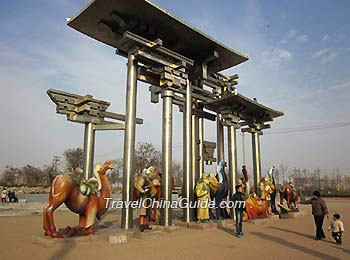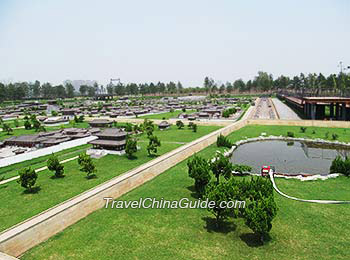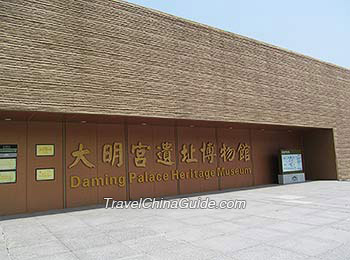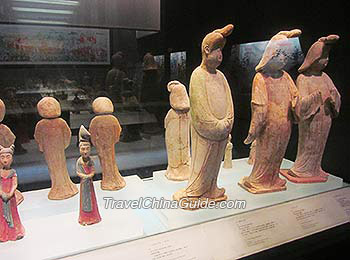Daming Palace Site of Tang Dynasty
Featuring its super-large scale and magnificent buildings, Daming Palace was the main royal palace in Tang Dynasty (618 - 907) where Tang emperors lived and dealt with state affairs. It was destroyed after Tang Dynasty. On June 22, 2014, it was included in the World Heritage List.
It was located in Longshou area in the northeast of Chang'an City (today's Xi'an). Covering a large area of 3 sq km (1.2 sq mi), it measured 2.5 km (1.6 mi) long and 1.4 km (0.9 mi) wide. Originally, the Emperor Li Shimin built it as the summer palace for his father, the Emperor Li Yuan. The palace had nine gates. The Daming Palace layout was composed of two areas, Qian Chao where emperors held court, and Nei Ting used for living and recreation.
Qian Chao comprised three palaces: Hanyuan Palace where grand ceremonies were held, Xuanzheng Palace where emperors administered state affairs, and Zichen Palace where ministers were presented to meet the emperor. Among them, Hanyuan Palace was the most famous and greatest.
Hanyuan Palace was the main palace, located about 600 m (656 yards) from Danfeng Gate, the middle south gate of Daming Palace. In the Tang Dynasty, it was an important international exchange center. On every New Year's Day, the emperors would hold great ceremonies there, and welcome ambassadors from various countries and the surrounding minorities. This majestic building reflected the great Tang Dynasty's prosperous and broad culture and represented the highest architectural level of that time.
The north part of Daming Palace was the garden areas for living and recreation. Linde Palace, located in the northwest, was the biggest attached palace. It was the place where emperors held banquets and received ambassadors. Built in rammed-earth construction, the site measured 130 m (142 yards) long and over 80 m (87 yards) wide. Taiye Pond, also called Penglai Pond was an oval-shaped pond, covering an area of 1.6 hectares (4 acres). As beautiful as a fairyland, the royal pond absorbed the essence of Tang's garden architecture.
The palace also had countless attractive and elegant attached buildings - pavilions, towers, and corridors. It is said that the Forbidden City was built according to the layout of Daming Palace. But to everyone's disappointment, this grand palace was burned out in the flames of war at the end of the Tang Dynasty. The cruel war left only the desolate and ruined site for us to imagine its glorious past.
Since 1950s, the archaeology work to Daming Palace has begun, and by far remarkable achievements have been gained through all experts' hard work. Besides the exploration in full scale, the experts made more efforts to unearth the sites of Hanyuan Palace, Linde Palace, Sanqing Palace, Xuanwu Gate and Chongquan Gate. In 1961, the State Council declared it as the national key cultural relic protection unit. The Daming Palace has been rebuilt and opened to the public on October 1st, 2010. About two thirds of the Daming Palace Site Park is admitted for free; the other one third of the park is cultural relics preservation and exhibition area.
 By Bus:
By Bus:
1. Take bus No. 2, 262, 528, 708, 717 or 723 and get off at Danfengmen (Danfeng Gate) Station.
2. Take bus No. 2, 17, 22, 38, 104, 209, 263, 309, 409, 517, 703, 703 (branch) or 801 and get off at Hanyuandian (Hanyuan Palace) Station or Daminggong Guojia Yizhi Gongyuan (Daming Palace National Heritage Park) Station.
 By Metro:
By Metro:
1. Take Metro Line 4 to Daminggong (Daming Palace Site of Tang Dynasty) directly.
2. Take Metro Line 2 to Daminggong Xi (Daming Palace West) Station and get out from Exit D. Walk towards east for 2 km (1.2 mi) or take a taxi with the cost of around CNY 10 in 5 minutes to the palace.
Xi'an Bus / Metro Search
It was located in Longshou area in the northeast of Chang'an City (today's Xi'an). Covering a large area of 3 sq km (1.2 sq mi), it measured 2.5 km (1.6 mi) long and 1.4 km (0.9 mi) wide. Originally, the Emperor Li Shimin built it as the summer palace for his father, the Emperor Li Yuan. The palace had nine gates. The Daming Palace layout was composed of two areas, Qian Chao where emperors held court, and Nei Ting used for living and recreation.
Qian Chao comprised three palaces: Hanyuan Palace where grand ceremonies were held, Xuanzheng Palace where emperors administered state affairs, and Zichen Palace where ministers were presented to meet the emperor. Among them, Hanyuan Palace was the most famous and greatest.
|
|
Hanyuan Palace was the main palace, located about 600 m (656 yards) from Danfeng Gate, the middle south gate of Daming Palace. In the Tang Dynasty, it was an important international exchange center. On every New Year's Day, the emperors would hold great ceremonies there, and welcome ambassadors from various countries and the surrounding minorities. This majestic building reflected the great Tang Dynasty's prosperous and broad culture and represented the highest architectural level of that time.
The north part of Daming Palace was the garden areas for living and recreation. Linde Palace, located in the northwest, was the biggest attached palace. It was the place where emperors held banquets and received ambassadors. Built in rammed-earth construction, the site measured 130 m (142 yards) long and over 80 m (87 yards) wide. Taiye Pond, also called Penglai Pond was an oval-shaped pond, covering an area of 1.6 hectares (4 acres). As beautiful as a fairyland, the royal pond absorbed the essence of Tang's garden architecture.
|
|
Since 1950s, the archaeology work to Daming Palace has begun, and by far remarkable achievements have been gained through all experts' hard work. Besides the exploration in full scale, the experts made more efforts to unearth the sites of Hanyuan Palace, Linde Palace, Sanqing Palace, Xuanwu Gate and Chongquan Gate. In 1961, the State Council declared it as the national key cultural relic protection unit. The Daming Palace has been rebuilt and opened to the public on October 1st, 2010. About two thirds of the Daming Palace Site Park is admitted for free; the other one third of the park is cultural relics preservation and exhibition area.
How to Get to Daming Palace Site
1. Take bus No. 2, 262, 528, 708, 717 or 723 and get off at Danfengmen (Danfeng Gate) Station.
2. Take bus No. 2, 17, 22, 38, 104, 209, 263, 309, 409, 517, 703, 703 (branch) or 801 and get off at Hanyuandian (Hanyuan Palace) Station or Daminggong Guojia Yizhi Gongyuan (Daming Palace National Heritage Park) Station.
1. Take Metro Line 4 to Daminggong (Daming Palace Site of Tang Dynasty) directly.
2. Take Metro Line 2 to Daminggong Xi (Daming Palace West) Station and get out from Exit D. Walk towards east for 2 km (1.2 mi) or take a taxi with the cost of around CNY 10 in 5 minutes to the palace.
Xi'an Bus / Metro Search
| Admission Fee | CNY 60 for cultural relics preservation and exhibition area including Danfeng Gate Heritage Museum, Daming Palace Heritage Museum, Archaeology Discovery Center and all individual palaces; the other two thirds area of the park is admitted for free. | |
| Opening Hours | March to October: 08:30-18:00 November to next February: 09:00-18:00 | |
Note:
1. Children under 1.2 m (3.9 ft) can enter for free.
2. Entrance ticket for children between 1.2-1.5 m (3.9-4.9 ft) is CNY 30 per person.
- Last updated on Aug. 15, 2024 by Catherine He -



